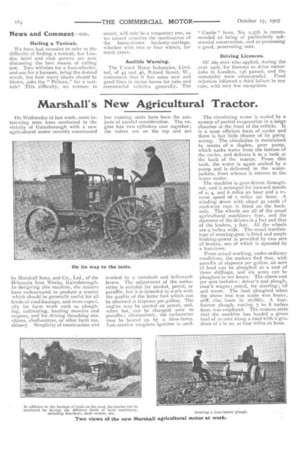Marshall' s New Agricultural Tractor.
Page 26

If you've noticed an error in this article please click here to report it so we can fix it.
On Wednesday of last week, some interesting tests were conducted in the vicinity of Gainsborougb with a new agricultural motor recently constructed by Marshall Sons, and Co., Ltd., of the Britannia Iron Works, Gainsborough. In designing this machine, the makers have endeavoured to produce a tractor which should be generally useful for all kinds of road-haulage, and more especi_ ally for farm work such as ploughing, cultivating, hauling mowers and reapers, and for driving thrashing machines, chaff-cutters, or other farm ma.. chinery. Simplicity of construction and low running costs have been the subjects of careful consideration. The engine has two cylinders cast together; the valves are on the top and are worked by a camshaft and bell-crank levers. The adjustment of the carburetter is suitable for alcohol, petrol, or paraffin, but it is intended to work with the quality of the latter fuel which can be obtained at sixpence per gallon. The engine may be started on petrol, and, when hot, can be changed over to paraffin ; alternatively, the carburetter may be heated up by a blow-lamp. how-tension magneto ignition is used.
The circulating water is cooled by a system of partial evaporation in a large chamber at the front of the vehicle. It is a most efficient form of cooler and there is but little chance of its going wrong. The circulation is maintained by means of a duplex, gear pump, which sucks water from the bottom of the cooler, and delivers it to a tank at the back of the tractor. From this tank, the water is again sucked by a pump and is delivered to the waterjackets, from whence it returns to the water cooler.
The machine is gear-driven throughout, and is arranged for forward speeds of 2, 4, and 6 miles an hour and a reverse speed of 2 miles an hour. A winding drum with about so yards of steel-wire rope is fitted on the back. axle. The wheels are all of the usual agricultural machinery type, and the diameter of the drivers is 4 feet and that of the leaders, 3 feet. All the wheels are 9 inches wide. The usual tractiontype of steering-gear is fitted and ample braking-power is provided by two sets of brakes, one of which is operated by a foot-lever.
From actual working, under ordinary conditions, the makers find that, with paraffin at sixpence per gallon, an acre of land can be ploughed at a cost of three shillings, and six acres can be ploughed in ten hours. The above cost per acre includes : driver's and plough_ man's wages ; petrol, for starting; oil and waste. The land ploughed when the above test was made was heavy, stiff, clay loam in stubble. A fourfurrow plough, cutting 7 to 8 inches deep, was employed. The makers state that the machine has hauled a gross load of to tons along a road with a gradient of m in 20, at four miles an hour.






























